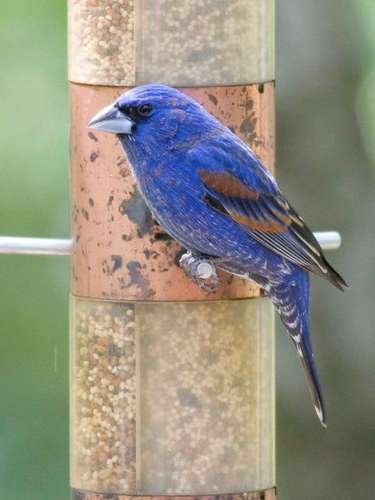Avian assessments indicate that FMR conservation sites serve a vital role for native fauna

One of the most exciting finds of recent years, a blue grosbeak was recently located in Pine Bend Bluffs only the fourth sighting on record in Dakota County.
Photo: Steve Kilpatrick
June is the month for breeding bird surveys, one of the job highlights for me and FMR Conservation Director Tom Lewanski. Among roughly 80 species detected over the last two years at multiple sites in Dakota and southern Washington Counties, some of the most exciting finds have been loggerhead shrike, mourning warbler, black-billed cuckoo, bobolink, sandhill crane, scarlet tanager and orchard orioles. In addition, 16 of the species detected have been identified by the Department of Natural Resources as species of greatest conservation need, generally due to habitat loss and population declines. The presence of these species is a compelling indication that the conservation sites we are working on serve a vital role for native fauna.
Breeding bird surveys are conducted in June when the majority of species breeding at a particular site are nesting and raising young. Its the best time of year to find out how habitat is being used by birds. While many other animals also utilize natural areas for breeding, birds are the easiest to detect and track over time. Many are also susceptible to subtle habitat changes, making them good indicators of habitat quality. Monitoring bird populations is an important method for evaluating habitat restoration projects. Watching the species composition change from four or five species found at a cropped farm field to 15 or more as the site is converted to prairie is an exciting process and a solid indication that things are progressing as they should. Long-term surveys of established forested areas are also an important tool for monitoring changes to bird populations over time. Individual bird species populations may change due to factors at the breeding site or thousands of miles away at the wintering grounds. Either way, the information is valuable for determining next steps for conservation or restoration work.
Breeding bird surveys are typically done in the wee morning hours, when birds are most vocal. It makes for some short nights, but with sunrise at 4:30 a.m., who can sleep in June anyway? In order to be able to compare data over time, both within a site and across a region, information gathering must follow some specific protocols. One of the most common survey methods is point counting. The observer arrives at designated points and records all birds seen or heard for a certain time period, such as five or eight minutes, and within a certain distance, such as 50 meters. With such a short observation time, and multiple points to get to, the observer is primarily reliant on identifying birds by their songs and calls.
I cannot finish this post without mention of one of the most exciting finds of recent years. On May 20th we located a blue grosbeak at a private property at Pine Bend Bluffs. This species is normally found in the very southwest corner of the state; this was only the fourth sighting on record for Dakota County. Without a doubt, this was simply a stray bird that had blown off-course, and was not ecologically indicative of anything. Nevertheless, it was exciting to see! The bird looks very much like an indigo bunting on steroids. Its larger than the bunting, with a heavier bill, and the male has prominent rusty wing bars.
Join the Audubon survey!
With a little practice, anyone can identify birds. Many excellent resources are available, from field guides to electronic recordings you can upload on an I-phone/pad/touch. Currently, Audubon Minnesota is conducting a five-year statewide survey to develop the first-ever bird atlas for the state. Volunteers are needed and the methods are very easy and casual no point counts or rigorous scientific methods just relaxed observation. Its a very fun way to watch birds and contribute to an important project.
Story credit: Karen Schik, Ecologist and Project Manager